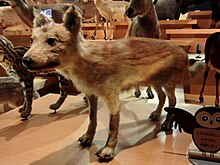| Japanese wolf | |
|---|---|

| |
| Mounted specimen of a Japanese wolf at the National Museum of Nature and Science, Tokyo, Japan | |
| Scientific classification | |
| Domain: | Eukaryota |
| Kingdom: | Animalia |
| Phylum: | Chordata |
| Class: | Mammalia |
| Order: | Carnivora |
| Family: | Canidae |
| Genus: | Canis |
| Species: | |
| Subspecies: | †C. l. hodophilax
|
| Trinomial name | |
| †Canis lupus hodophilax | |
| Synonyms | |
The Japanese wolf (Japanese: ニホンオオカミ(日本狼), Hepburn: Nihon ōkami, or 山犬, yamainu [see below]; Canis lupus hodophilax), also known as the Honshū wolf, is an extinct subspecies of the gray wolf that was once endemic to the islands of Honshū, Shikoku and Kyūshū in the Japanese archipelago.
It was one of two subspecies that were once found in the Japanese archipelago, the other being the Hokkaido wolf. Genetic sequencing indicates that the Japanese wolf was highly divergent from living wolf populations.
Despite long being revered in Japan, the introduction of rabies and canine distemper to Japan led to the decimation of the population, and policies enacted during the Meiji Restoration led to the persecution and eventual total extermination of the subspecies by the early 20th century. Well-documented observations of similar canids have been made throughout the 20th and 21st centuries, and have been suggested to be surviving wolves. However, due to environmental and behavioral factors, doubts persist over their identity.[4][5][6]
- ^ Boitani, L.; Phillips, M.; Jhala, Y. (2018). "Canis lupus". IUCN Red List of Threatened Species. 2018: e.T3746A163508960. doi:10.2305/IUCN.UK.2018-2.RLTS.T3746A163508960.en. Retrieved 19 November 2021.
- ^ Temminck, C. J. (1839) Over de Kennis en de Verbreiding der Zoogdieren van Japan. Tijidschrift voor Natuurlijke Geschiedenis en Physiologie, pt5, 274–293 – refer page 284
- ^ a b Cite error: The named reference
smithsonian2005was invoked but never defined (see the help page). - ^ "In search of Japan's lost wolves: Primal howl". Deep reads from The Japan Times. Retrieved 2021-10-29.
- ^ Martin, Alex K. T. (2019-05-25). "In search of Japan's extinct wolves: Sightings of a mysterious canine in Chichibu have been captivating animal enthusiasts". The Japan Times. Retrieved 2021-10-29.
- ^ "In search of Japan's lost wolves: Territorial threat". Deep reads from The Japan Times. Retrieved 2021-10-29.
